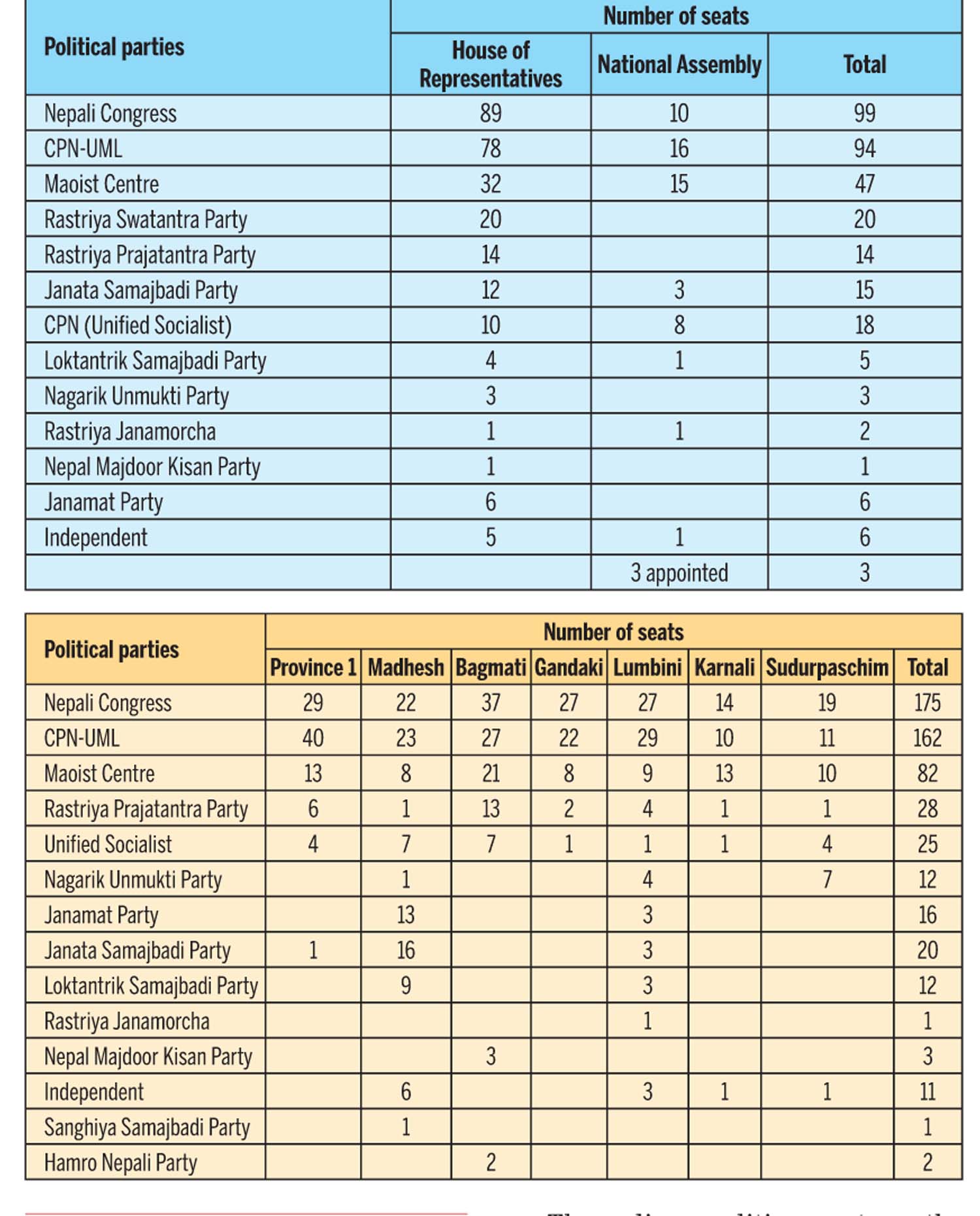Politics
5 parties have numbers to pick their President
Multiple aspirants from various parties eye the top post.
Nishan Khatiwada
With the November poll results out, political parties have expedited negotiations on forming a new government and electing a new head of the state.
The presidential election (elections of the President and the Vice-president) are held based on a weighted voting system.
Although it is a ceremonial position, many political leaders have publicly expressed their desire to become the President. Some of those eyeing the job are CPN (Unified Socialist) chair Madhav Kumar Nepal and senior leader Jhala Nath Khanal; incumbent Vice-president Nanda Bahadur Pun, former prime minister Baburam Bhattarai, former Speakers from the Maoist Centre Agni Sapkota, Krishna Bahadur Mahara and Onasari Gharti; plus, Nepali Congress leaders Ram Chandra Poudel, Krishna Prasad Sitaula and Gopal Man Shrestha. Meanwhile, there have been reports that some top leaders are mulling electing someone from a non-political background as the head of state at the instigation of foreign powers.
The electoral college for the presidential poll consists of 884 members, including 275 members of the House of Representatives (lower house), 59 members of the National Assembly (upper house) and 550 members of seven provincial assemblies.
Article 62 (1) of the constitution states: “The President shall be elected by an electoral college composed of the members of the federal parliament and the provincial assemblies. The voting weightage of the members of the federal parliament and of the provincial assemblies shall vary as provided for in the federal law.”

Article 62 (3) states that a person who secures a majority of the then existing total votes of the electoral college referred to in Clause (1) shall be elected as President. Article 62 (4) states: “In case none of the candidates secures a majority pursuant to Clause (3), there shall be the voting between the two candidates who have secured the highest number of votes, and a candidate who secures more than 50 percent of the total votes in such voting shall be elected as the President.”
Dr Ram Baran Yadav, a Nepali Congress leader, was elected the first President replacing the king as the head of the state and served for more than seven years.
And on October 28, 2015, Yadav was succeeded as President by Bidya Devi Bhandari, a woman leader from the CPN-UML. She will be leaving Sheetal Niwas after the members of the federal parliament and provincial assemblies elect her replacement over the next few weeks.
In the election for President, a vote cast by a member of both upper and lower houses will be considered to have the weight of 79 votes, whereas the vote cast by a member of the provincial assembly will have the weight of 48 electoral votes.
It means, there will be a total weightage of 52,786 votes in the electoral college, if no seat in federal parliament and provincial assembly is vacant.
The Congress-led ruling coalition, should it remain intact, has enough numbers to elect its candidate as President.
A December 5 meeting of the ruling coalition has decided to continue the partnership. “The federal and provincial poll results have confirmed the significance and necessity of the current coalition,” stated a press statement jointly issued by Congress President Sher Bahadur Deuba, CPN (Maoist Centre) chair Pushpa Kamal Dahal, CPN (Unified Socialist) chair Madhav Kumar Nepal and Rastriya Janamorcha vice-chair Durga Poudel.
If it remains the case for the ruling coalition as proclaimed by its leaders, electing a President will be more challenging than picking a prime minister, given the multiple aspirants for the ceremonial job.
Similarly, the second-largest party, the CPN-UML has a total weightage of 15,202, including 7,426 in the federal Parliament and 7,776 in provincial assemblies. The Congress has a total weightage of 16,221—7,821 in the federal Parliament and 8,400 in the provincial assemblies. Similarly, the Maoist Centre has 7,649, including 3,713 in the federal Parliament and 3,936 in provincial assemblies.
The fourth-largest force in the lower House, the Rastriya Swatantra Party, did not contest the provincial elections, hence has the weightage of just 1,580. The Rastriya Prajatantra Party (RPP), an ally of the CPN-UML in the major polls, has the total weightage of 2,540, while another ally, the JSP, has 2,145.
The JSP has already claimed that its electoral alliance with the CPN-UML has ended with the conclusion of the elections. But the RPP has not officially spoken yet on its partnership with the CPN-UML. However, its leaders claim that their first choice would be to remain in the opposition.
The ruling coalition partner, the Unified Socialist, has a weightage of 2,622, while the Loktantrik Samajbadi Party (LSP) has 971 and the Rastriya Janamorcha 206.
Similarly, two new parties— Janamat Party and Nagarik Unmukti Party—that are mulling over supporting the ruling coalition have the weightages of 1,242 and 813, respectively. Likewise, independent candidates have a weightage of 1,002, in total.
The total weightage of the Congress, the Maoist Centre, the Unified Socialist, the Loktantrik Samajbadi Party and the Rastriya Janamorcha is 27,669—more than enough to secure a majority, which is 26,394.
To form a government at the centre, the ruling coalition is trying to woo the Janamat Party, the Nagarik Unmukti Party and a few independent candidates, as it is two seats short of a majority. If they come on board, their added weightage will make the presidential election easier for the coalition.




 12.12°C Kathmandu
12.12°C Kathmandu













%20(1).jpg&w=300&height=200)

